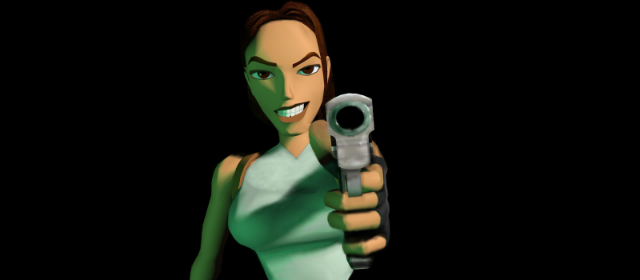Name: Lara Croft
Games: Tomb Raider – Tomb Raider Chronicles (1996 – 2000)
Species: Human
In her own words: “Walk to the edge with the white line until I stop. Then let go of walk and tap backwards to give me a run-up. Press forward, and almost immediately press and hold the jump button. While I’m in the air, press and hold the action button, to make me grab the ledge…”
This week’s Character Select is about Lara Croft, but in a departure from the vast majority of Lara Croft articles (and indeed episodes of Character Select), it’s not going to discuss sexuality, appearance, gender or the character’s contribution to narrative or the cultural legacy of Tomb Raider. It’s not going to talk about the character’s changing biography, her status as a mid-90s Britpop relic or even the post-imperialist tensions implicit in the tale of an English aristocrat gleefully stealing the treasures of distant lands.
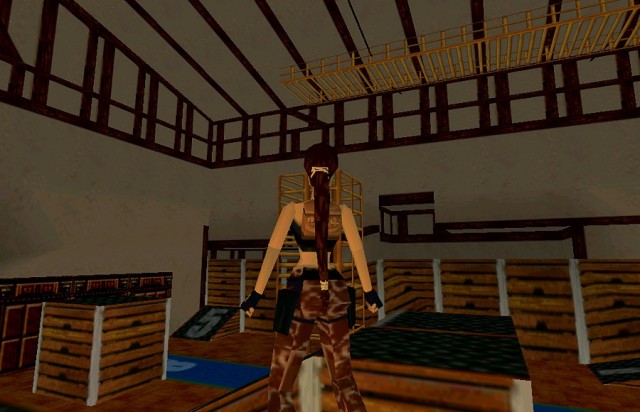
The gym, where Lara learns to perform running the infamous jump-and-grab.
Lara Croft is arguably bigger than Tomb Raider itself. Without wishing to get into a chicken-and-egg discussion about whether Lara’s charisma made Tomb Raider successful or whether Tomb Raider’s revolutionary gameplay catapulted its heroine to stardom, it’s fair to say that many, many more people know who Lara Croft is than have ever played Tomb Raider. As a result of this (and the fact that the series has been re-invented several times) the gameplay in the classic Tomb Raider games tends to get overlooked.
Actually, that’s not quite true. It is discussed, but generally only in the most negative terms. While Crystal Dynamics received deserved praise for their more agile (and, in Underworld, motion-captured) Lara, criticism of the Core games began and ended with Lara Croft’s heavy, rigid control system. Such criticism is not invalid. Controlling Core’s Lara can feel a little like manoeuvring a loaded shopping trolley around an obstacle course, especially if you’re not used to it. Jumping controls are notoriously awkward, and the sheer number of buttons you have to press to execute a running-jump-and-grab seems utterly ridiculous by today’s standards.
But forget everything you know about, and expect, from action games, and Lara Croft’s move-set sheds light on what made classic Tomb Raider so compelling. Mastering the timing and sequences of the button presses seems outrageously complicated at first, but taken in context with Tomb Raider’s distinctive level design, it begins to make sense.
Classic Tomb Raider games were built out of blocks. Square blocks, about as wide as Lara was tall. On large flat surfaces, you could see the seams between the textures of two adjacent blocks. These “blocks” might destroy immersion for today’s HD-spoiled players perhaps, and they became a laughing stock in Tomb Raider Chronicles, the fifth game in as many years from the small British developer who found themselves with an unexpected global phenomenon on their hands, but they didn’t trouble wide-eyed adventure gamers back in 1996. More importantly, these blocks gave players vital clues as to how and when they were required to press certain buttons in order to get from one side of a room to another.
Each of Lara’s jumps covered a set number of blocks, and trickier gaps required you to count the “seams” to work out whether you’d need to perform a standing jump, a running jump, or a jump-and-grab in order to traverse them. It seems an archaic system by today’s standards, and that’s before you’ve taken into account the sheer complexity of each move.
Performing a running jump and grab, for example, requires six button pushes, more if you’re doing it at an angle or you need to twist in mid-air. First, you have to line yourself up with the edge of the block you wish to jump off. That requires holding the “walk” button, and then pressing “forward” until Lara’s toes are touching the ledge. For simplicity’s sake, we’re going to imagine that this isn’t one of those complicated angled jumps that requires you to make tiny directional adjustments then check them repeatedly using the “look” button. Once you’ve lined yourself up, you need to give yourself a run-up. To do that, you’ll need to let go of “walk” and tap “back”. That’s tap, mind you, hold it too long and you’ll need to line Lara up all over again.
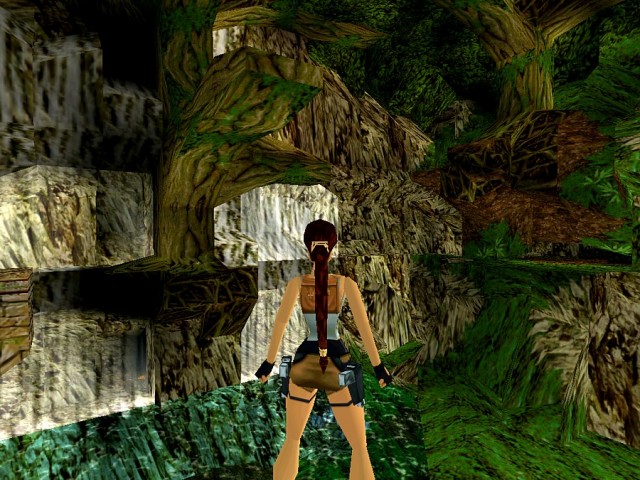
The Indian jungle is made out of blocks.
Lined up? Good. Now it’s time to run and jump. Press “forward” and almost immediately after, press and hold “jump”. Lara won’t actually jump when you press jump, but when she’s reached the edge of the block. Now, the thing you’re trying to reach is further away than Lara can jump, so press and hold “action” while she’s flying through the air. She’ll stick out her hands, and attach herself to the ledge on the other side. Now, she’ll be dangling off the ledge, so you’ll have to pull up using “forward”, or execute a nifty (if pointless) hand-stand by pressing “walk” and “forward”. You’re still holding “action”, right? Well, you’d know if you weren’t. Those crocodiles down there look hungry.
Lara rivals a classic beat-em-up character in the number of combos she has, and the complexity of the movements required to perform them. The difference is, of course, that whereas a beat-em-up player can coast along by mashing buttons, a Tomb Raider player has to master every single combo if they’re going to complete the game. This isn’t Bayonetta, getting “really good” isn’t something you do because you get to make the character do more incredible things, or to unlock trophies. No, “really good” is the minimum, and you aren’t even rewarded with an agile character or a pyrotechnic display for your trouble.
So why did anyone ever bother? One reasons is that successful piloting of Lara was rewarded with another mysterious place, a sense of accomplishment and the rather magical feeling that you were exploring something that mankind had never seen before. Classic Tomb Raider isn’t deliberately difficult in the way Dark Souls is (and neither can it boast that game’s tactile and responsive, if unforgiving, control system), but there’s a certain potency to the feeling of accomplishment you get from completing a tricky sequence that the two have in common. The other is more complex, wrapped up in Tomb Raider’s gameplay: A unique combination of action and classic adventure puzzling.
For while the gameplay of Tomb Raider is rooted in platforming, its structure is that of a point-and-click. The player must analyse Lara’s environment, solve puzzles, and interact with objects and items in one part of a level in order to create a path in another. Lara Croft’s controls are built to facilitate this structure and, in a way, controlling her is as much a puzzle as figuring out how to operate one of the ancient mechanisms she so often finds herself faced with.
The aforementioned block-based level design played a huge part in helping the player figure out where secret doors were, because they knew how many blocks Lara could cover in a jump, or how high she could reach. With such a rigid set of moves, it became clear what precisely was stopping Lara from reaching the tantalising artefact on the other side of the room and thus what would need to change about the environment to help her reach it. In a way, then, Lara Croft’s movements were more figurative than literal. Though she looked more like a real person than almost any other 3D video game character of the time, her move set was more like a combination lock then a simulation of human movement, and only the right sequence would open the door to the next area.
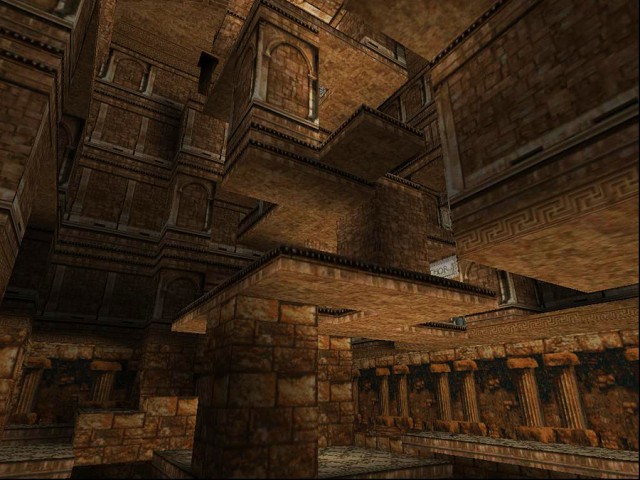
The central area of St Francis Folly in Tomb Raider
That’s why enjoyment of classic Tomb Raider gameplay is dependent on judging it on its own unique terms, not as the platformer it initially seems like. That said, it’s interesting to make a comparison between the first Tomb Raider and perhaps its closest peer, Mario 64, released only a few months earlier. Mario 64 was a landmark 3D platformer that saw its hero effortlessly transition from two dimensions to three, miraculously retaining the tactile responsiveness that had made him so successful up until that point. Measured by the same yardstick, Tomb Raider was, of course, a colossal failure.
By far the most painful sections of the original Tomb Raider were are those which required dexterity and timing, which is in stark contrast to Mario 64, a completely enjoyable game comprised of almost nothing but dexterity and timing. Although, minute-for-minute, exploration and puzzle solving make up far more of classic Tomb Raider games than complex jump-and-grab sequences, those episodes are still mightily frustrating, even for the seasoned raider.
But it’s not as if they weren’t deliberate. On the contrary, Tomb Raider’s unforgiving block-based jumping puzzles were intentionally designed to require the player to assume complete mastery of Lara Croft. In the commentary to Tomb Raider Anniversary, Crystal Dynamic’s 2007 graceful cover version of the original Tomb Raider, original designer Toby Gard can be heard explaining the design decisions behind the original game. A fire-trap sequence, spectacularly re-imagined in Anniversary, prompts Gard to recall how the room was designed in the earlier game:
“Originally […] the room was all about the fact that Lara worked like clockwork, so if you kind of start a jump at certain point, once she lands there’s […] a specific point when she can jump again, […] if you push the button earlier, it’s still going to be that specific time.”
(If you’re interested, the original sequence, executed precisely as Gard describes, by Tina Von Rotter, can be viewed here, while the updated version of the room can be seen in this relic collection video by Stellalune).
Tomb Raider’s firetrap, and Gard’s explanation of it, is a perfect illustration of the one thing that makes the gameplay, Lara Croft’s character design and her relationship with the world, so compelling despite its cruel difficulty. That is, that there is a way, one perfect way, to execute every move in the game, to reach every door, to retrieve every artefact, to avoid every painful death. And there’s a way because the world is built for Lara, and built to allow her to succeed. In his book “Trigger Happy”, Stephen Poole considers this in terms of how players relate to the game:
As Lara Croft’s creator has explained, “the whole Tomb Raider world is utterly dependent on Lara’s size and animations. The distance she can jump, reach, run forward and fall are set variables. In this way, her world is designed for her to exist in.” How strangely comforting. We are everywhere alienated from nature in the real world, but for a time we can feel oddly at home in this unreal universe, where our strengths can always overcome our difficulties. We prefer the fantasy because it is fair.
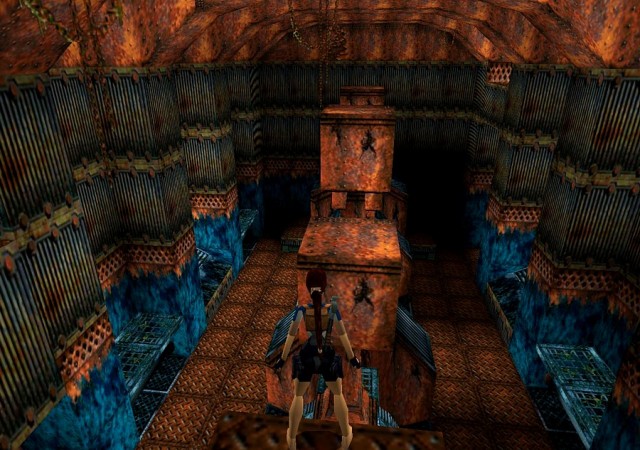
Lara will need to find the controls to move the machinery in this room if she’s to cross it.
There was a time, not so very long ago, when it was accepted that the sun, moon and stars revolved around the earth. Well-reasoned arguments to the contrary were met with disapproval at best, ex-communication at worst. Politics and questions of church and state aside, this isn’t all too surprising. It’s natural for humans to want to believe that we’re the centre of the universe, that everything we see or experience was built just for us. Evidence to the contrary is frightening, instilling in us a sense of vertigo. Could it be that everything we know exists purely through chance?
As Poole deftly points out, Tomb Raider, with its clockwork heroine and perfectly-proportioned game world gives us a reassuring escape from such notions. Of course, this is something that all but the most badly-designed or wilfully artistic games give us, but rarely is it expressed more clearly than Tomb Raider. Lara Croft is a slightly deviant explorer who lives for the thrill of breaking into places where she shouldn’t be, and improvising ways to fix ancient mechanisms decayed by time.
Yet the entire world, from the temples she plunders to the cliffs she scales to reach them, is built for her. Sure, it might be a puzzle and the player may have to master some preposterously complex finger-gymnastics to conquer it, but there’s always a way. This is what makes becoming classic Lara Croft such a potent escape from reality: though you may seem like an interloper, really, you’re the mistress of the entire world.
All the screenshots in this article are taken from Skribblerz.com.


